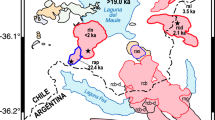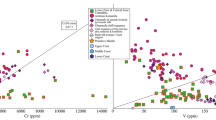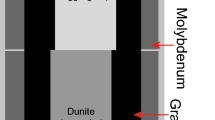Abstract
Strontium, Nd, Pb, Hf, Os, and O isotope compositions for 30 Quaternary lava flows from the Mount Adams stratovolcano and its basaltic periphery in the Cascade arc, southern Washington, USA indicate a major component from intraplate mantle sources, a relatively small subduction component, and interaction with young mafic crust at depth. Major- and trace-element patterns for Mount Adams lavas are distinct from the rear-arc Simcoe volcanic field and other nearby volcanic centers in the Cascade arc such as Mount St. Helens. Radiogenic isotope (Sr, Nd, Pb, and Hf) compositions do not correlate with geochemical indicators of slab-fluids such as (Sr/P) n and Ba/Nb. Mass-balance modeling calculations, coupled with trace-element and isotopic data, indicate that although the mantle source for the calc-alkaline Adams basalts has been modified with a fluid derived from subducted sediment, the extent of modification is significantly less than what is documented in the southern Cascades. The isotopic and trace-element compositions of most Mount Adams lavas require the presence of enriched and depleted mantle sources, and based on volume-weighted chemical and isotopic compositions for Mount Adams lavas through time, an intraplate mantle source contributed the major magmatic mass of the system. Generation of basaltic andesites to dacites at Mount Adams occurred by assimilation and fractional crystallization in the lower crust, but wholesale crustal melting did not occur. Most lavas have Tb/Yb ratios that are significantly higher than those of MORB, which is consistent with partial melting of the mantle in the presence of residual garnet. δ 18O values for olivine phenocrysts in Mount Adams lavas are within the range of typical upper mantle peridotites, precluding involvement of upper crustal sedimentary material or accreted terrane during magma ascent. The restricted Nd and Hf isotope compositions of Mount Adams lavas indicate that these isotope systems are insensitive to crustal interaction in this juvenile arc, in stark contrast to Os isotopes, which are highly sensitive to interaction with young, mafic material in the lower crust.













Similar content being viewed by others
References
Bacon CR, Druitt TH (1988) Compositional evolution of the zoned calc-alkaline magma chamber of Mount Mazama, Crater Lake, Oregon. Contrib Mineral Petrol 98:224–256. doi:10.1007/BF00402114
Bacon CR, Gunn SH, Lanphere MA, Wooden JL (1994) Multiple isotopic components in quaternary volcanic rocks of the Cascade arc near Crater Lake, Oregon. J Petrol 35:1521–1556
Bacon CR, Bruggman PE, Christiansen RL, Clynne MA, Donnelly-Nolan JM, Hildreth W (1997) Primitive magmas at five Cascade volcanic fields: melts from hot, heterogeneous sub-arc mantle. Can Mineral 35:397–423
Baedecker PA (1987) Methods for geochemical analysis. US Geol Surv Bull 1770, pp 132
Baker MB, Grove TL, Kinzler RJ, Donnely-Nolan Wandless GA (1991) Origin of compositional zonation (high-alumina basalt to basaltic andesite) in the Giant Crater lava field, Medicine Lake volcano, northern California. J Geophys Res 96:21819–21842. doi:10.1029/91JB01945
Bartels KS, Kinzler RJ, Grove TL (1991) High pressure phase relations of primitive high-alumina basalts from Medicine Lake volcano, northern California. Contrib Mineral Petrol 108:253–270. doi:10.1007/BF00285935
Barth MG, Foley SF, Horn I (2002) Partial melting in Archean subduction zones: constraints from experimentally determined trace element partition coefficients between eclogitic minerals and tonalitic melts under upper mantle conditions. Precambrian Res 113:323–340. doi:10.1016/S0301-9268(01)00216-9
Berlo K, Turner S, Blundy J, Hawkesworth C (2004) The extent of U-series disequilibria produced during partial melting of the lower crust with implications for the formation of the Mount St Helens dacites. Contrib Mineral Petrol 148:122–130. doi:10.1007/s00410-004-0590-2
Blondes MS, Reiners PW, Ducea MN, Singer BS, Chesley J (2008) Temporal-compositional trends over short and long time-scales in basalts of the Big Pine Volcanic Field, California. Earth Planet Sci Lett 269:140–154. doi:10.1016/j.epsl.2008.02.012
Blundy JD, Robinson JAC, Wood BJ (1998) Heavy REE are compatible in clinopyroxene on the spinel lherzolite solidus. Earth Planet Sci Lett 160:493–504. doi:10.1016/S0012-821X(98)00106-X
Borg LE, Clynne MA, Bullen TD (1997) The variable role of slab-derived fluids in the generation of a suite of primitive calc-alkaline lavas from the southernmost Cascades, California. Can Mineral 35:425–452
Borg LE, Clynne MA (1998) The petrogenesis of felsic calc-alkaline magmas from the southernmost Cascades, California: origin by partial melting of basaltic lower crust. J Petrol 39:1197–1222. doi:10.1093/petrology/39.6.1197
Borg LE, Brandon AD, Clynne MA, Walker RJ (2000) Re–Os isotopic systematics of primitive lavas from the Lassen region of the Cascade Arc, California. Earth Planet Sci Lett 177:301–317. doi:10.1016/S0012-821X(00)00051-0
Borg LE, Blichert-Toft J, Clynne M (2002) Ancient and modern subduction zone contributions to the mantle sources of lavas from the Lassen region of California inferred from Lu–Hf isotopic systematics. J Petrol 43:705–723. doi:10.1093/petrology/43.4.705
Brandon AD, Becker H, Carlson RW, Shirey SB (1999) Isotopic constraints on time scales and mechanisms of slab material transport in the mantle wedge: evidence from the Simcoe mantle xenoliths, Washington, USA. Chem Geol 160:387–407. doi:10.1016/S0009-2541(99)00109-6
Brandon AD, Creaser RA, Shirey SB, Carlson RW (1996) Osmium recycling in subduction zones. Science 272:861–864 doi:10.1126/science.272.5263.861
Bullen JD, Clynne MA (1990) Trace element and isotopic constraints on magmatic evolution at the Lassen Volcanic Center. J Geophys Res 95:19671–19691. doi:10.1029/JB095iB12p19671
Chesley JT, Ruiz J (1998) Crust-mantle interaction in large igneous provinces: implications from Re-Os systematics of the Columbia River basalts. Earth Planet Sci Lett 154:1–11
Church SE, Tilton GR (1973) Lead and strontium isotopic studies in the Cascade Mountains; bearing on andesite genesis. Geol Soc Am Bull 84:431–454. doi :10.1130/0016-7606(1973)84<431:LASISI>2.0.CO;2
Church SE (1976) The Cascade Mountains revisited; a re-evaluation in light of new lead isotopic data. Earth Planet Sci Lett 29:175–188. doi:10.1016/0012-821X(76)90037-6
Clynne MA (1993) Geologic studies of the Lassen Volcanic Center, Cascade Range. California. Ph.D. Thesis, University of California, Santa Cruz
Clynne MA, Borg LE (1997) Olivine and chromian spinel in primitive calc-alkaline and tholeiitic lavas from the southernmost Cascade range, California: a reflection of relative fertility of the source. Can Mineral 35:453–472
Conrey RM, Sherrod DR, Hooper PR, Swanson DA (1997) Diverse primitive magmas in the Cascade arc, northern Oregon and southern Washington. Can Mineral 35:367–396
Conrey RM, Hooper PR, Larson PB, Chesley J, Ruiz J (2001) Trace element and isotopic evidence for two types of crustal melting beneath a High Cascade volcanic center, Mt. Jefferson, Oregon. Contrib Mineral Petrol 141:710–732
Doe BR, Delevaux MH (1973) Variations in Lead-Isotopic Compositions in Mesozoic Granitic Rocks of California; preliminary investigation A. Geol Soc Am Bull 84:3213–3526
Druitt TH, Bacon CR (1989) Petrology of the zoned calc-alkaline magma chamber of Mount Mazama, Crater Lake, Oregon. Contrib Mineral Petrol 101:245–259. doi:10.1007/BF00375310
Elkins Tanton LT, Grove TL, Donnelly-Nolan J (2001) Hot, shallow mantle melting under the Cascades volcanic arc. Geology 29:631–634. doi :10.1130/0091-7613(2001)029<0631:HSMMUT>2.0.CO;2
Gaetani GA, Grove TL (2003) Experimental constraints on melt generation in the mantle wedge. In: Eiler J (ed) The subduction factory. AGU, Washington DC. Geophys Monogr Ser 138:107–134
Gill JB (1981) Orogenic andesites and plate tectonics, 330 pp. Springer-Verlag, New York
Grove TL, Parman SW, Bowring SA, Price RC, Baker MB (2002) The role of an H2O-rich fluid component in the generation of primitive basaltic andesites and andesites from the Mt. Shasta region, N California. Contrib Mineral Petrol 142:375–396
Grove TL, Elkins-Tanton LT, Parman SW, Chatterjee N, Müntener O, Gaetani G (2003) Fractional crystallization and mantle melting controls on calc-alkaline differentiation trends. Contrib Mineral Petrol 145:515–533. doi:10.1007/s00410-003-0448-z
Hacker BR, Abers GA, Peacock SM (2003) Subduction factory 1—theoretical mineralogy, densities, seismic wave speeds, and H2O contents: J Geophys Res 108. ESE 10:1–26
Halliday AN, Fallick AE, Dickin AP, Mckenzie AB, Stephens WE, Hildreth W (1983) The isotopic and chemical evolution of Mount St Helens. Earth Planet Sci Lett 63:241–256. doi:10.1016/0012-821X(83)90040-7
Hart GL (2002) Isotope study of magmatic processes and crustal recycling in subduction zone environments in the Cascade range of northwestern US. [Ph.D. thesis] University of Wisconsin-Madison, 210 p
Hart GL, Johnson CM, Shirey SB, Clynne MA (2002) Osmium isotope constraints on lower crustal recycling and pluton preservation at Lassen volcanic center, CA. Earth Planet Sci Lett 199:269–285. doi:10.1016/S0012-821X(02)00564-2
Hart GL, Johnson CM, Hildreth W, Shirey SB (2003) New osmium isotope evidence for intra-crustal recycling of crustal domains with discrete ages. Geology 31:427–430. doi :10.1130/0091-7613(2003)031<0427:NOIEFI>2.0.CO;2
Hart SR (1984) A large-scale isotopic anomaly in the southern hemispheric mantle. Nature 309:753–757. doi:10.1038/309753a0
Hart WK, Aranson JL, Mertzman SA (1984) A real distribution and age of low-K, high-alumina olivine tholeiite magmatism in the northwestern Great Basin. Geol Soc Am Bull 95:186–195. doi :10.1130/0016-7606(1984)95<186:ADAAOL>2.0.CO;2
Hart WK, Carlson RW, Shirey SB (1997) Radiogenic Os in primitive basalts from the northwestern U.S.A.: implications for petrogenesis. Earth Planet Sci Lett 150:103–116
Hawkesworth CJ, Hergt JM, Ellam RM, McDermott F (1991) Elements fluxes associated with subduction related magmatism. Philos Trans R Soc Lond Ser A 335:393–405. doi:10.1098/rsta.1991.0054
Hegner E, Tatsumoto M (1987) Pb, Sr, and Nd isotopes in basalts and sulfides from the Juan de Fuca Ridge. J Geophys Res 92:11380–11386. doi:10.1029/JB092iB11p11380
Hildreth W (2007) Quaternary magmatism in the Cascades-geologic perspectives. US Geol Surv Prof Pap 1744, pp 125
Hildreth W, Fierstein J (1995) Geologic map of the Mount Adams volcanic field, Cascade Range of southern Washington. US Geol Surv Map I-2460, scale 1:50,000
Hildreth W, Fierstein J (1997) Recent eruptions of Mount Adams, Washington Cascades, USA. Bull Volcanol 58:472–490. doi:10.1007/s004450050156
Hildreth W, Lanphere MA (1994) Potassium-argon geochronology of a basaltandesite-dacite arc system: the Mount Adams volcanic field, Cascade Range of southern Washington. Geol Soc Am Bull 106:1413–1429. doi :10.1130/0016-7606(1994)106<1413:PAGOAB>2.3.CO;2
Hooper PR, Steele WK, Conrey RM, Smith GA, Anderson JL, Bailey DG et al (1993) The Prineville Basalt, north-central Oregon. Or Geol 55:3–12
Jicha BR, Singer BS, Brophy JG, Fournelle JH, Johnson CM, Beard BL et al (2004) Variable impact of the subducted slab on Aleutian Island arc magma sources: Evidence from Sr, Nd, Pb, and Hf isotopes and trace element abundances. J Petrol 45:1845–1875. doi:10.1093/petrology/egh036
Johnson CM, Thompson RA (1991) Isotopic composition of Oligocene mafic volcanic rocks in the northern Rio Grande Rift; evidence for contributions of ancient intraplate and subduction magmatism to evolution of the lithosphere. J Geophys Res 96:13593–13608. doi:10.1029/91JB00342
Karsten JL, Delaney JR, Rhodes JM, Raimo AL (1990) Spatial and temporal evolution of magmatic systems beneath the endeavour segment, Juan de Fuca ridge: tectonic and petrologic constraints. J Geophys Res 95:19256–19325. doi:10.1029/JB095iB12p19235
Klein M, Stosch HG, Seck HA, Shimizu N (2000) Experimental partitioning of high field strength and rare earth elements between clinopyroxene and garnet in andesitic to tonalitic systems. Geochim Cosmochim Acta 64:99–115. doi:10.1016/S0016-7037(99)00178-7
Lapen TJ, Mahlen NJ, Johnson CM, Beard BL (2004) High precision Lu and Hf isotope analyses of both spiked and unspiked samples: a new approach. Geochem Geophys Geosyst 5. doi:10.1029/2003GC000852
Leeman WP, Smith DR, Hildreth W, Palacz Z, Rogers N (1990) Compositional diversity of Late Cenozoic basalts in a transect across the southern Washington Cascades: implications for subduction zone magmatism. J Geophys Res 95:1958–19561. doi:10.1029/JB095iB12p19561
Leeman WP, Tonarini S, Chan LH, Borg L (2004) Boron and lithium isotopic variation in a hot subduction zone__the southern Washington Cascades. Chem Geol 212:101–124. doi:10.1016/j.chemgeo.2004.08.010
Leeman WP, Lewis JF, Evarts RC, Conrey RM, Streck MJ (2005) Petrologic constraints on the thermal structure pf the Cascades arc. J Volcanol Geotherm Res 140:67–105. doi:10.1016/j.jvolgeores.2004.07.016
Mattey D, Lowry D, Macpherson C (1994) Oxygen isotope composition of mantle peridotite. Earth Planet Sci Lett 128:231–241. doi:10.1016/0012-821X(94)90147-3
McBirney AR, White CM (1982) The Cascade Province. In: Thorpe RS (ed) Andesites: orogenic andesites and related rocks, Wiley, New York, pp 115–135
McDade P, Blundy J, Wood B (2003) Trace element partitioning of the Tinaquillo Lherzolite solidus at 1.5 GPa. Phys Earth Planet Inter 139:129–147. doi:10.1016/S0031-9201(03)00149-3
Mercer CN, Johnston AD (2008) Experimental studies of the P–T–H2O near-liquidus phase relations of basaltic andesite from North Sister volcano, High Oregon Cascades: constraints on lower-crustal mineral assemblages. Contrib Mineral Petrol 155:571–592. doi:10.1007/s00410-007-0259-8
Miyashiro A (1974) Volcanic rock series in island arcs and active continental margins. Am J Sci 274:2077–2094
Mooney WD, Weaver CS (1989) Regional crustal structure and tectonics of the Pacific coastal states; California, Oregon, and Washington. Geol Soc Am 172:129–161
Parsons T, Trehu AM, Luetgart JH, Miller K, Kilbride F, Wells RE, Fisher MA, Fleuh E, ten Brink US, Christensen NI (1998) A new view into the Cascadia subduction zone and volcanic arc: implications for earthquake hazards along the Washington margin. Geology, 26, 199–202. doi :10.1130/0091-7613(1998)026<0199:ANVITC>2.3.CO;2
Plank T, Langmuir CH (1998) The geochemical composition of subducting sediment and its consequences for the crust and mantle. Chem Geol 145:325–394
Prytulak J, Vervoort JD, Plank T, Yu C (2006) Astoria Fan sediments. DSDP site 174, Cascadia Basin: Hf–Nd-Pb constraints on provenance and outburst flooding. Chem Geol 233:276–292. doi:10.1016/j.chemgeo.2006.03.009
Reiners PW, Hammond PE, McKenna JM, Duncan RA (2000) Young basalts of the central Washington Cascades, flux melting of the mantle and trace element signatures of primary arc magmas. Contrib Mineral Petrol 138:249–264. doi:10.1007/s004100050561
Righter K, Chesley JT, Ruiz J (2002) Genesis of primitive, arc-type basalt: constraints from Re, Os, and Cl on the depth of melting and role of fluids. Geology 30:619–622. doi :10.1130/0091-7613(2002)030<0619:GOPATB>2.0.CO;2
Saal AE, Rudnick RL, Ravizza GE, Hart SR (1998) Re–Os isotope evidence for the composition, formation and age of the lower continental crust. Nature 393:58–61. doi:10.1038/29966
Schmidt ME, Grunder AL, Rowe MC (2008) Segmentation of the Cascade arc as indicated by Sr and Nd isotopic variation among diverse primitive basalts. Earth Planet Sci Lett 266:166–181. doi:10.1016/j.epsl.2007.11.013
Schmidt MW, Poli S (1998) Experimentally based water budgets for dehydrating slabs and consequences for arc magma generation. Earth Planet Sci Lett 163:361–379. doi:10.1016/S0012-821X(98)00142-3
Sherrod DR, Smith JG (1990) Quaternary extrusion rates of the Cascade Range, northwestern United States and southern British Columbia. J Geophys Res 95:19465–19474. doi:10.1029/JB095iB12p19465
Sun S-S, McDonough WF (1989) Chemical and isotopic systematics of oceanic basalts: implications for mantle composition and processes. In: Saunders AD, Norry MJ (eds) Magmatism in the Ocean Basins. Blackwell Scientific, London, pp 313–345
Taylor HP Jr, Sheppard S (1986) Igneous rocks: I. Processes of isotopic fractionation and isotope systematics. In: Valley JW, Taylor HP, O’Neil JR Jr (eds) Reviews in mineralogy 16: stable isotopes in high temperature geological processes. Mineralogical Society of America, Washington DC, pp 227–271
Turner S, Foden J, George R, Evans P, Varne R, Elburg M et al (2003) Rates and processes of potassic magma evolution beneath Sangeang Api volcano, east Sunda arc, Indonesia. J Petrol 44:491–515. doi:10.1093/petrology/44.3.491
Valley JW, Kitchen NE, Kohn MJ, Niendorf CR, Spicuzza MJ (1995) UWG-2, A garnet standard for oxygen isotope ratio: strategies for high precision and accuracy with laser heating. Geochim Cosmochim Acta 59:5223–5231. doi:10.1016/0016-7037(95)00386-X
van Westrenen W, Blundy JD, Wood BJ (2001) High field strength element/rare earth element fractionation during partial melting in the presence of garnet: implications for identification of mantle heterogeneities. Geochem Geophys Geosys 2:2000GC000133
Watson EB, Harrison TM (1983) Zircon saturation revisited; temperature and composition effects in a variety of crustal magma types. Earth Planet Sci Lett 64:295–304. doi:10.1016/0012-821X(83)90211-X
White WM, Hofmann AW, Puchelt H (1987) Isotope geochemistry of Pacific mid-ocean ridge basalt. J Geophys Res 92:4881–4893. doi:10.1029/JB092iB06p04881
Widom E, Kepezhinskas PK, Defant M (2003) The nature of metasomatism in the sub-arc mantle wedge; evidence from Re–Os isotopes in Kamchatka peridotite xenoliths. Chem Geol 196:283–306. doi:10.1016/S0009-2541(02)00417-5
Wood DA, Joron JL, Treuil M (1979) A re-appraisal of the use of trace elements to classify an discriminate between magma series erupted in different tectonic settings. Earth Planet Sci Lett 45:326–336. doi:10.1016/0012-821X(79)90133-X
Workman RK, Hart SR (2005) Major and trace element composition of the depleted MORB mantle (DMM). Earth Planet Sci Lett 231:53–72. doi:10.1016/j.epsl.2004.12.005
Acknowledgments
This work was supported by grants from NSF (EAR-9980512, EAR-0309853), GSA, Sigma Xi, and the Department of Geology and Geophysics at the University of Wisconsin-Madison. Mike Spicuzza assisted in analysis of oxygen isotope ratios. Judy Fierstein was a partner in the mapping and stratigraphy on which this investigation was based. Reviews by Michael Clynne, Michael Sawlan, and two anonymous reviewers greatly improved the manuscript.
Author information
Authors and Affiliations
Corresponding author
Additional information
Communicated by T.L. Grove.
Rights and permissions
About this article
Cite this article
Jicha, B.R., Hart, G.L., Johnson, C.M. et al. Isotopic and trace element constraints on the petrogenesis of lavas from the Mount Adams volcanic field, Washington. Contrib Mineral Petrol 157, 189–207 (2009). https://doi.org/10.1007/s00410-008-0329-6
Received:
Accepted:
Published:
Issue Date:
DOI: https://doi.org/10.1007/s00410-008-0329-6




